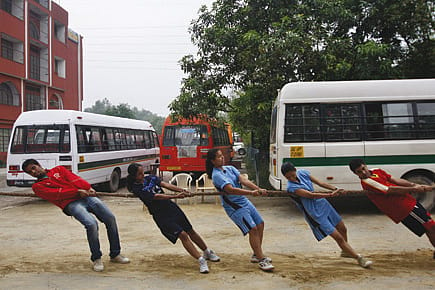The Tug of War Groupies

A sport that few take seriously also has some serious contestants
Eight of them are lined up, arranged tallest to shortest. On a shout of 'ready', they pull on a rope about three inches thick, at the end of which is a drum filled with mud and stones. This weighs 480 kg, and is placed on a contraption which makes it rise as they pull. Between calls of 'lock' (when they dig in their heels) and 'pull', the eight hoick up the drum with reasonable ease. The practice session of the Tug of War Federation is happening in a cramped, bad-tempered part of Delhi with 20-odd boys and girls from their mid-teens to mid-20s. "There are 40-odd training centres in the city," says Madan Mohan, a former national-level player who is now secretary of the Federation.
The Federation, established in 1958 in Ghaziabad, was almost exclusively a defence forces' association when it started. Now, the sport's adherents cut across all categories. There are 25 state associations, with presence in three Union territories and nine national tournaments held annually.
The sport is not easy to play at a competitive level. It's painful. First of all, you need to learn to weather the rope, because three inches of coarse cord can bruise your palms raw. Then, there's the pulling, which requires enormous muscle strength: the weight categories start at 480 kg (ultra-featherweight) and go up to 680 kg in India. When a team 'locks' to resist the other team's pull, players often manage to keep standing at a gobsmacking 1400 angle to the ground. At times, for a whole minute. A typical match lasts four to five minutes. If it goes beyond six minutes, the rules decree a re-match.
Many of the better tug of war players are already state or national level players in another sport, usually wrestling and weightlifting. Madhvi Patil, president of the Tug of War Association for Maharashtra, was a national-level weightlifter. "My training helped, because it's a sport where your muscles need to be developed. You can get seriously injured."
At the two national level meets, Maharashtra, Manipur, Punjab and Delhi are the states that excel. But 50-60 teams turn up from all over now, says Mohan. Tug of war, though, is still not a professional sport. Not in India or anywhere in the 58 countries that play it competitively. Compare that to kabaddi and kho-kho: the first is played in 28 countries, and the second, two (just India and Pakistan).
